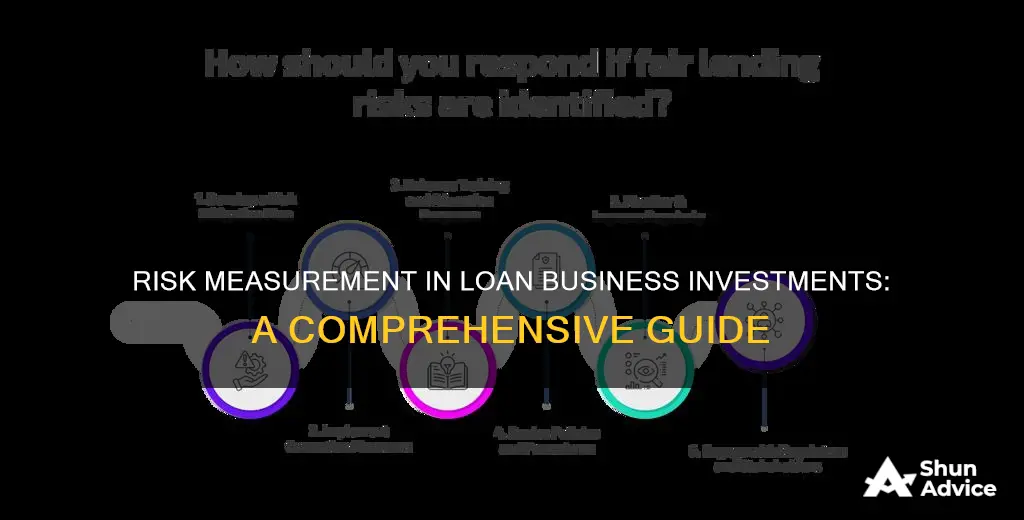
Risk is an important concept in the loan business investment sector, and understanding how to measure it is crucial for investors. The level of risk an investor is willing to accept depends on their risk tolerance, which is a key factor in investment decisions. There are several methods to measure risk, including statistical measures and complex mathematical models. Common risk measures include standard deviation, value at risk (VaR), conditional value at risk (CVaR), and financial ratios such as the debt-to-capital ratio, debt-to-equity ratio, and interest coverage ratio. These tools help investors assess the potential downsides and align their investments with their risk tolerance and financial goals.
What You'll Learn

Loan-to-value (LTV)
The LTV ratio is calculated by dividing the loan amount by the total value of the underlying asset, then multiplying by 100 to get a percentage. For example, if you borrow $90,000 to buy a home valued at $100,000, the LTV is 90% (90,000/100,000 x 100).
Lenders consider loans with high LTV ratios to be higher-risk. Therefore, these loans usually come with higher interest rates. A high LTV indicates heavy reliance on debt, increasing vulnerability during economic downturns or fluctuations in asset value. A low LTV, on the other hand, reflects robust financial management and reduced financial risk, providing greater security and financial flexibility to investors.
In commercial real estate, average LTV ratios typically range from 65% to 80%. For example, multifamily housing properties average 73% LTV, while commercial investment properties like office spaces and retail centres average around 68%. Business properties like hotels and restaurants usually max out at 70% LTV.
LTV is a critical metric for investors to evaluate the risk behind an investment. It is one of the tools used to assess a borrower's loan proposal. A lower LTV provides a greater "cushion" for the lender if the borrower defaults and the lender has to sell the collateral to recoup their investment.
Why Safe Investments Are Not Always Bad
You may want to see also

Capitalization rate (cap rate)
Capitalization Rate, or Cap Rate, is a measure used in commercial real estate investments to calculate the profitability potential of a property. It is a ratio of the net operating income produced by an asset to its original price or current market value. The formula for calculating the cap rate is:
Cap Rate = (Net Operating Income / Current Market Value) x 100%
The net operating income (NOI) is the income generated by the property after covering all operational expenses, including property taxes, insurance fees, and maintenance costs. The current market value of the property is the price at which it could be sold in the current market.
The cap rate is an important tool for investors as it provides a comparison between different real estate investments. A higher cap rate indicates higher risk and potentially higher returns, while a lower cap rate suggests lower risk and possibly lower returns. However, it should not be used as the sole indicator of an investment's strength, as it does not take into account leverage, the time value of money, or future cash flows.
The cap rate can also influence an investor's perception of risk. A higher cap rate may indicate that an investment is riskier, even if other factors suggest otherwise. On the other hand, a lower cap rate could make an investor view a property as less risky, potentially overlooking potential red flags.
In terms of loan negotiations, the cap rate plays a crucial role. A high cap rate may signal to lenders that there are elevated risks associated with an investment, such as lower rental incomes or depreciation of the property. Conversely, a lower cap rate might suggest lower risks, making the investment seem more attractive to lenders.
Overall, the capitalization rate is a vital component in real estate valuations, providing investors with a threshold to guide their financial decisions and shape their perception of risk.
Minimizing Risk: Strategies of Investment Bankers
You may want to see also

Interest coverage ratio
The interest coverage ratio is a basic measure of a company's ability to service its short-term financing costs and handle its outstanding debt. It is calculated by dividing a company's earnings before interest and taxes (EBIT) by its interest expense during a given period. The ratio value reveals the number of times a company can make its required annual interest payments on its outstanding debt with its current earnings before interest and taxes (EBIT).
A lower interest coverage ratio indicates a greater debt service burden on the company and a higher risk of default or financial insolvency. An interest coverage ratio of 1.5 or lower is considered indicative of potential financial problems related to debt servicing. A higher ratio indicates stronger financial health and the company's ability to meet interest obligations.
The interest coverage ratio is also called the "times interest earned" (TIE) ratio. It is used by lenders, investors, and creditors to determine a company's risk profile for future borrowing.
For example, if a company's earnings before taxes and interest amount to $50,000 and its total interest payment requirements equal $25,000, then its interest coverage ratio is 2.0 ($50,000/$25,000 = 2). This means the company can pay its interest payments twice over with its current earnings.
The interest coverage ratio is an important metric for creditors and investors to assess a company's ability to pay back its debt and interest expenses.
Corporate Investment Management: Strategies for Business Growth
You may want to see also

Standard deviation
In the context of investments, standard deviation helps determine market volatility or the spread of asset prices from their average price. A high standard deviation indicates that prices are moving wildly and the investment is more risky. On the other hand, a low standard deviation means that prices are more stable and the investment carries less risk.
However, standard deviation has its limitations as a risk measurement tool. It is based on past data, which may not be indicative of future performance. Additionally, it assumes a normal distribution of data values, which may not hold true for all types of investments. Therefore, it should be used in conjunction with other risk measurement functions to make more informed investment decisions.
A Beginner's Guide to Investing in SGB in India
You may want to see also

Alpha
A positive alpha indicates that the fund has generated higher returns than expected, given the level of risk. On the other hand, a negative alpha suggests that the fund has underperformed relative to the benchmark and may indicate higher investment risk.
When comparing potential investments, it is important to compare similar investments to determine which holds the most risk. By considering the alpha value, investors can make more informed decisions about the potential risk and return of their investments.
In addition to alpha, other financial ratios can be used to assess a company's financial health and investment risk. These include the debt-to-capital ratio, debt-to-equity ratio, interest coverage ratio, and degree of combined leverage. These ratios provide insights into a company's capital structure, debt management, and overall financial soundness, helping investors make informed decisions about potential investments.
Equity Investments: Understanding Misconceptions and Correct Statements
You may want to see also







